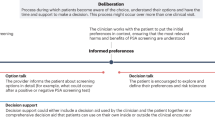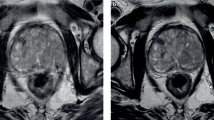Abstract
Purpose
The prostate biopsy pathology report represents a critical document used for decision-making in patients diagnosed with prostate cancer, yet the content exceeds the health literacy of most patients. We sought to create and compare the effectiveness of a patient-centered prostate biopsy report compared with standard reports.
Materials and methods
Using a modified Delphi approach, prostate cancer experts identified critical components of a prostate biopsy report. Patient focus groups provided input for syntax and formatting of patient-centered pathology reports. Ninety-four patients with recent prostate biopsies were block randomized to the standard report with or without the patient-centered report. We evaluated patient activation, self-efficacy, provider communication skills, and prostate cancer knowledge.
Results
Experts selected primary and secondary Gleason score and the number of positive scores as the most important elements of the report. Patients prioritized a narrative design, non-threatening language and information on risk classification. Initial assessments were completed by 87% (40/46) in the standard report group and 81% (39/48) in the patient-centered report group. There were no differences in patient activation, self-efficacy, or provider communication skills between groups. Patients who received the patient-centered report had significantly improved ability to recall their Gleason score (100% vs. 85%, p = 0.026) and number of positive cores (90% vs. 65%, p = 0.014). In total, 86% of patients who received the patient-centered report felt that it helped them better understand their results and should always be provided.
Conclusions
Patient-centered pathology reports are associated with significantly higher knowledge about a prostate cancer diagnosis. These important health information documents may improve patient-provider communication and help facilitate shared decision-making among patients diagnosed with prostate cancer.
This is a preview of subscription content, access via your institution
Access options
Subscribe to this journal
Receive 4 print issues and online access
$259.00 per year
only $64.75 per issue
Buy this article
- Purchase on Springer Link
- Instant access to full article PDF
Prices may be subject to local taxes which are calculated during checkout



Similar content being viewed by others
References
Truog RD. Patients and doctors-evolution of a relationship. N Engl J Med. 2012;366:581–5.
Blumenthal D, Tavenner M. The “meaningful use” regulation for electronic health records. N Engl J Med. 2010;363:501–4.
DesRoches CM, Audet AM, Painter M, Donelan K. Meeting meaningful use criteria and managing patient populations: a national survey of practicing physicians. Ann Intern Med. 2013;158:791–9.
White S, Dillow S Key. Concepts and Features of the 2003 National Assessment of Adult Literacy. Washington, DC: National Center for Education Statistics; 2005.
Keselman A, Logan R, Smith CA, Leroy G, Zeng-Treitler Q. Developing informatics tools and strategies for consumer-centered health communication. J Am Med Inform Assoc. 2008;15:473–83.
Mossanen M, True LD, Wright JL, Vakar-Lopez F, Lavallee D, Gore JL. Surgical pathology and the patient: a systematic review evaluating the primary audience of pathology reports. Hum Pathol. 2014;45:2192–201.
Mossanen M, Calvert JK, Wright JL, True LD, Lin DW, Gore JL. Readability of urologic pathology reports: the need for patient-centered approaches. Urol Oncol. 2014;32:1091–4.
Hasson F, Keeney S, McKenna H. Research guidelines for the Delphi survey technique. J Adv Nurs. 2000;32:1008–15.
Friedman DB, Hoffman-Goetz L. A systematic review of readability and comprehension instruments used for print and web-based cancer information. Health Educ Behav. 2006;33:352–73.
Flesch R. A new readability yardstick. J Appl Psychol. 1948;32:221–33.
Mossanen M, Macleod LC, Chu A, Wright JL, Dalkin B, Lin DW, et al. Comparative effectiveness of a patient centered pathology report for bladder cancer care. J Urol. 2016;196:1383–9.
Hibbard JH, Mahoney ER, Stockard J, Tusler M. Development and testing of a short form of the patient activation measure. Health Serv Res. 2005;40:1918–30.
ten Klooster PM, Oostveen JC, Zandbelt LC, Taal E, Drossaert CH, Harmsen EJ, et al. Further validation of the 5-item Perceived Efficacy in Patient-physician Interactions (PEPPI-5) scale in patients with osteoarthritis. Patient Educ Couns. 2012;87:125–30.
Mercer SW, Maxwell M, Heaney D, Watt GC. The consultation and relational empathy (CARE) measure: development and preliminary validation and reliability of an empathy-based consultation process measure. Fam Pract. 2004;21:699–705.
Bennett C, Graham ID, Kristjansson E, Kearing SA, Clay KF, O’Connor AM. Validation of a preparation for decision making scale. Patient Educ Couns. 2010;78:130–3.
Nielsen-Bohlman L, Panzer AM, Kindig DA, Institute of Medicine. Health literacy: a prescription to end confusion. Washington, D.C: The National Academy Press; 2004.
Berkman ND, Sheridan SL, Donahue KE, Halpern DJ, Crotty K. Low health literacy and health outcomes: an updated systematic review. Ann Intern Med. 2011;155:97–107.
Husson O, Mols F, van de Poll-Franse LV. The relation between information provision and health-related quality of life, anxiety and depression among cancer survivors: a systematic review. Ann Oncol. 2011;22:761–72.
Levit L, Balogh E, Nass S, Ganz PA, Institute of Medicine. Delivering high-quality cancer care: charting a new course for a system in crisis. Washington, D.C: National Academy Press; 2013.
Synnot A, Bragge P, Lowe D, Nunn JS, O’Sullivan M, Horvat L, et al. Research priorities in health communication and participation: international survey of consumers and other stakeholders. BMJ Open. 2018;8:e019481.
Harrison JD, Young JM, Price MA, Butow PN, Solomon MJ. What are the unmet supportive care needs of people with cancer? A systematic review. Support Care Cancer. 2009;17:1117–28.
Donovan JL, Hamdy FC, Lane JA, Mason M, Metcalfe C, Walsh E, et al. Patient-reported outcomes after monitoring, surgery, or radiotherapy for prostate cancer. N Engl J Med. 2016;375:1425–37.
Wilt TJ, Brawer MK, Jones KM, Barry MJ, Aronson WJ, Fox S, et al. Radical prostatectomy versus observation for localized prostate cancer. N Engl J Med. 2012;367:203–13.
Hamdy FC, Donovan JL, Lane JA, Mason M, Metcalfe C, Holding P, et al. 10-year outcomes after monitoring, surgery, or radiotherapy for localized prostate cancer. N Engl J Med. 2016;375:1415–24.
Cooperberg MR, Carroll PR. Trends in management for patients with localized prostate cancer, 1990–2013. J Am Med Assoc. 2015;314:80–2.
Hoffman KE, Niu J, Shen Y, Jiang J, Davis JW, Kim J, et al. Physician variation in management of low-risk prostate cancer: a population-based cohort study. JAMA Intern Med. 2014;174:1450–9.
Kendel F, Helbig L, Neumann K, Herden J, Stephan C, Schrader M, et al. Patients’ perceptions of mortality risk for localized prostate cancer vary markedly depending on their treatment strategy. Int J Cancer. 2016;139:749–53.
Dale W, Bilir P, Han M, Meltzer D. The role of anxiety in prostate carcinoma: a structured review of the literature. Cancer. 2005;104:467–78.
Hoffman RM, Lo M, Clark JA, Albertsen PC, Barry MJ, Goodman M, et al. Treatment decision regret among long-term survivors of localized prostate cancer: results from the prostate cancer outcomes study. J Clin Oncol. 2017;35:2306–14.
Musunuru HB, Yamamoto T, Klotz L, Ghanem G, Mamedov A, Sethukavalan P, et al. Active surveillance for intermediate risk prostate cancer: survival outcomes in the sunnybrook experience. J Urol. 2016;196:1651–8.
Acknowledgements
The authors acknowledge the research support from the Pacific Northwest Prostate Cancer SPORE (P50-CA097186) and the Institute for Prostate Cancer Research.
Funding
This work was supported by the Pacific Northwest Prostate Cancer SPORE (P50-CA097186) and the Institute for Prostate Cancer Research.
Author information
Authors and Affiliations
Corresponding author
Ethics declarations
Conflict of interest
The authors declare that they have no conflict of interest.
Additional information
Publisher’s note: Springer Nature remains neutral with regard to jurisdictional claims in published maps and institutional affiliations.
Rights and permissions
About this article
Cite this article
Nayak, J.G., Scalzo, N., Chu, A. et al. The development and comparative effectiveness of a patient-centered prostate biopsy report: a prospective, randomized study. Prostate Cancer Prostatic Dis 23, 144–150 (2020). https://doi.org/10.1038/s41391-019-0169-7
Received:
Revised:
Accepted:
Published:
Issue Date:
DOI: https://doi.org/10.1038/s41391-019-0169-7
This article is cited by
-
Multi-pilot implementation experiences of patient-centered pathology reports: lessons learned for the advancement of patient-centered tools for cancer decision-making
Cancer Causes & Control (2023)
-
Exploring the value of using patient-oriented MRI reports in clinical practice — a pilot study
Supportive Care in Cancer (2022)



